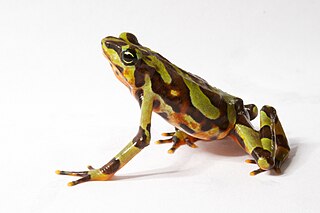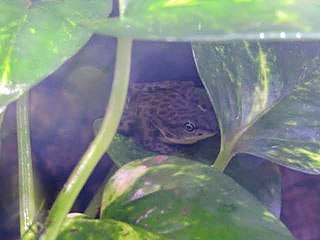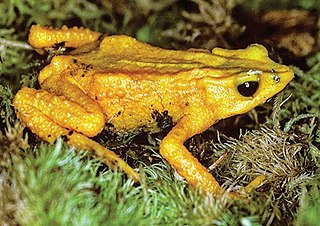
Atelopus is a large genus of Bufonidae, commonly known as harlequin frogs or toads, from Central and South America, ranging as far north as Costa Rica and as far south as Bolivia. Atelopus species are small, generally brightly colored, and diurnal. Most species are associated with mid-to-high elevation streams.

Atelopus longirostris is a species of harlequin frog, a member of the family of true toads (Bufonidae). It has been recorded only in northern Ecuador. Records from Colombia probably represent different species. As of mid-2017, it is listed as extinct by the IUCN, but was rediscovered in 2016 after more than two decade with no sightings, likely because the IUCN last assessed it in 2004. The scientific name of this species means "long-snout" and the species has been named in Spanish as the jambato hocicudo. Common names longnose stubfoot toad, scrawny stubfoot-toad, and longnose sharlequin frog have been coined for it.

Atelopus varius, the Costa Rican variable harlequin toad or clown frog, is a small Neotropical true toad from the family Bufonidae. Once ranging from Costa Rica to Panama, A. varius is now listed as critically endangered and has been reduced to a single remnant population near Quepos, Costa Rica and has only relict populations in western Panama (IUCN). Recent variation in air temperature, precipitation, stream flow patterns, and the subsequent spread of a pathogenic chytrid fungus (Batrachochytrium dendrobatidis) linked to global climate change have been the leading cause of decline for A. varius. A. zeteki has been considered a subspecies of A. varius, but is now generally considered a separate species.

Atelopus balios, the Rio Pescado stubfoot toad, is a species of toad in the family Bufonidae. It is endemic to southwestern Ecuador, with records from Pacific lowlands in Azuay, Cañar, and Guayas Provinces. It is a rare species that was already suspected to be extinct, but a single specimen was discovered in 2011 by a team from Conservation International during a hunt for missing amphibians. The decline in amphibian populations is well documented. The Atelopus balios is Critically Endangered as a result of the widespread amphibian Chytridiomycosis fungus that has decimated other amphibian populations. There are only 10 known findings of the tadpole, Atelopus balios.

Atelopus carbonerensis, also known as the Venezuelan yellow frog and La Carbonera stubfoot toad, is a species of toad in the family Bufonidae. It is endemic to the Mérida Andes of Venezuela. Following an observation in 1998, it was feared extinct for nearly two decades until a single individual was sighted in 2014, followed by an observation of a mating pair in 2021.

The Guajira stubfoot toad or Carrikeri harlequin frog is a species of toad in the family Bufonidae. It is about 5 cm (2.0 in) long and typically black, though some populations have orange coloration. This species is endemic to the Sierra Nevada de Santa Marta mountain range of northern Colombia. It is critically endangered because of the chytrid fungus, Batrachochytrium dendrobatidis, and habitat destruction due to agriculture. The species had not been seen from 1994 until it was rediscovered in early 2008.

Atelopus certus, the Darien stubfoot toad or Toad Mountain harlequin frog, is a species of toad in the family Bufonidae endemic to Panama.

Atelopus chiriquiensis, the Chiriqui harlequin frog or Lewis' stubfoot toad, is an extinct species of toad in the family Bufonidae that was found in the Cordillera de Talamanca in Costa Rica and western Panama. Its natural habitats were stream margins in lower montane wet forests and rainforests. Its elevational range was 1,400–2,500 m (4,600–8,200 ft) asl.
Atelopus farci, the forest stubfoot toad, is a species of toad in the family Bufonidae. It is endemic to Colombia and only known from its type locality, Granjas del Padre Luna, in Albán, Cundinamarca, on the western flank of the Cordillera Oriental at about 2,100 m (6,900 ft) above sea level. Its natural habitat is cloud forest where it lives in streams.

Atelopus glyphus, the Pirri harlequin frog or Pirri Range stubfoot toad, is a species of toad in the family Bufonidae found in Colombia and Panama within the Northwestern Andean montane forests. Its natural habitats are subtropical or tropical moist montane forests and rivers.

Atelopus ignescens, the Jambato toad or Quito stubfoot toad or Jambato harlequin frog, is a species of toad in the family Bufonidae. It is endemic to the northern Andes of Ecuador. This once abundant species was believed to be extinct until its rediscovery in 2016. The specific name ignescens means "to catch fire," presumably in reference to the orange ventral color of this species.
The Mindo stubfoot toad or Mindo harlequin-toad is a species of toad in the family Bufonidae. It is endemic to Ecuador in Pichincha, Santo Domingo and Cotopaxi Provinces. Its natural habitats are subtropical or tropical moist lowland forests, subtropical or tropical moist montane forests, and rivers. It has a unique appearance and color pattern, being green and red with white speckles, and due to this it was once considered an emblematic species of the Mindo Valley.
The green and red venter harlequin toad is a species of toad in the family Bufonidae. It is endemic to Venezuela. Its natural habitats are subtropical or tropical moist montane forests, rivers, and intermittent rivers. It is threatened by habitat loss.
Atelopus planispina is a species of toad in the family Bufonidae. It is endemic to the eastern slopes of the Andes of Ecuador. According to the IUCN SSC Amphibian Specialist Group, it is restricted to the Napo Province, although other sources suggest somewhat wider range. It has not been seen since 1985 and might already be extinct. Common names Planispina's harlequin frog, Napo stubfoot toad, and flat-spined atelopus have been coined for it.

Atelopus pulcher is a species of toad in the family Bufonidae. It is endemic to eastern Peru where it is found in the Huallaga River drainage; its range might extend to Ecuador. Its natural habitats are lowland and premontane tropical forests. It is a diurnal and terrestrial species that breeds in streams.
The Tamá harlequin frog or Venezuela stubfoot toad is a species of toad in the family Bufonidae. It is endemic to the Páramo de Tamá on the Venezuelan-Colombian border and occurs in Apure and (likely) Táchira states of Venezuela and Norte de Santander Department on the Cordillera Oriental of Colombia.
The three-coloured harlequin toad is a species of toad in the family Bufonidae. It is found in Bolivia and Peru. Its natural habitats are subtropical or tropical moist montane forests and rivers. It is threatened by habitat loss.
Atelopus vogli is an extinct species of harlequin frog in the family Bufonidae. It was endemic to Venezuela. It is known from collections in two localities: its type locality, Las Peñas near Hacienda la Trinidad in Aragua, and Montalbán in Carabobo. It was first described as subspecies of Atelopus cruciger. The specific name vogli honours Cornelius Vogl, German priest who was a missionary in Venezuela in 1925–1959. Common name Vogl's harlequin toad has been coined for it.










